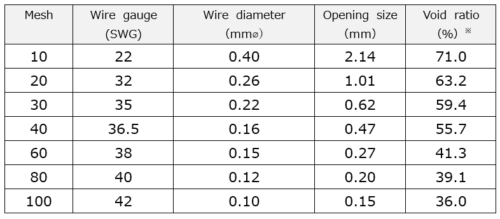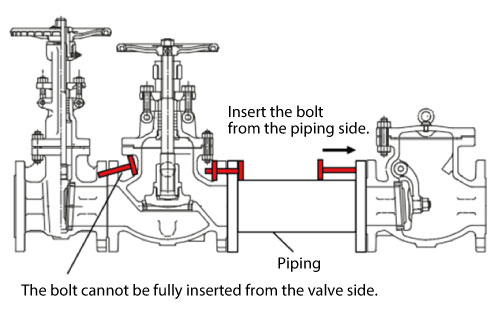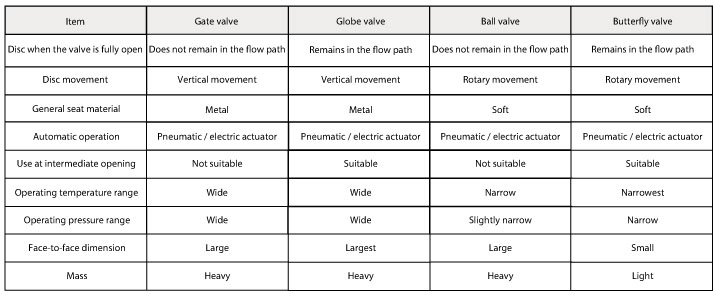Frequently Asked Questions
We have summarized the questions that you often inquire about.Please refer to it before you inquire.
See “Trouble Shooting” for information on problems.
- Detailed Search
-
Search by Product
Search by Category
Search by Keyword
- What is the capacity coefficient (Cv value) of a valve?
-
The capacity coefficient of a valve indicates a “coefficient that represents the capacity of flow at a given travel under certain conditions.” (From JIS B 0100, Glossary of Terms for Valves)
It is a coefficient that expresses something like the performance that allows fluid to flow through a valve under specified conditions such as the valve opening degree and the pressure difference before and after the valve (differential pressure). The Cv value is often used as one of the capacity coefficients. The larger the Cv value, the easier the fluid to flow.
- Where can I get the “Strategic Materials Non-Applicable Certificate” for a product?
-
“Security trade documents” can be issued from our website.
Please click “Security Trade Document Issuance Service” and download the certificate of the target product.
When viewing or downloading, please use it after user registration.
- Is it possible to purchase maintenance parts?
-
Since we sell maintenance parts, please contact your dealer for the scope of supply.
- Are there any precautions when installing valves or when using them?
-
Please refer to the precautions described in the instruction manual of each type of valve.
- Are there the SDSs (Safety Data Sheets) (former MSDSs) for valves?
-
We do not have SDSs for the valves themselves, but we have SDSs for the valve parts seats, paints, and coating agents used during assembly. So, please contact your dealer.
- Is it possible to bury valves for piping?
-
We do not recommend to bury valves for installation. Prepare a valve box even when using a valve for burying.
- The catalog says “Applicable fluids: Water, oil and gas.” Is it possible to use the valve with air as well.
-
Air can also be used, but please use the valve within the maximum allowable pressure of each product.
- Tell me the mesh wire diameters and void ratios of the screens.
-
The mesh wire diameters and void ratios are as follows. (Inner mesh dimensions used by us)

- What is the difference between the inner thread type and the outer thread type of gate valves? In addition, what should I check to confirm each product?
-
・ Inner thread type
This type has a structure in which the threaded part is provided inside the valve (the part that comes into contact with water).
Since the height is lower than the outer thread type, this type has an advantage that the height of the valve chamber can be lowered.・Outer thread type
This type has a structure in which the threaded part is provided outside the valve (the part that does not come into contact with water).
Because of the advantage that maintenance of the threaded part and parts replacement can be done easily, the outer thread type is used when the opening and closing frequency is high (electric operation, etc.).
- Is it possible to connect one valve to another valve directly for piping?
-
We do not recommend connecting the valves directly for piping.
Because of the valve structure, there is a possibility of interference as shown in the figure when passing bolts. Normally, a short pipe is sandwiched and the bolts are inserted from the pipe side, and the nuts are tightened on the valve side. Therefore, when installing a valve and a valve, be sure to use a short pipe to connect them for piping.
- Do you have valves that comply with the Food Sanitation Act?
-
The Food Sanitation Law does not apply to a valve alone, but it stipulates the prohibition of metals containing lead and/or antimony, and prohibition of structures where copper and/or lead can be scraped for devices, containers and packages.
SDSs are available for non-metallic resin and rubber soft parts used in valves, so please contact your dealer.
- Do you have valves with which the handle does not move up and down?
-
Gate valves with non-rising structure (inner screw type) and quarter-turn valves (ball valves, butterfly valves) are applicable.
- What information is required for valve selection?
-
Basic information of “① Desired valve type, ② Connection method, ③ Size (nominal diameter), ④ Fluid operating temperature, ⑤ Fluid operating pressure, ⑥ Fluid name (including concentration and component values), ⑦ Material used for piping, etc.” is required.
In addition, please let us know the “use environment” and “application” as much as possible.
- What information should be communicated to identify a valve in the existing piping?
-
Since there is no product code described on the actual product, please contact your nearest sales office with “check items such as face distance, casted display, nameplate content” and, if possible, “images”.
- Where should I order to purchase the valve?
-
Please contact a dealer of pipe materials that has business with your company.
- Is it possible to constantly use an EKE type drive part with electric stroke on one side and spring return on the other side?
-
It is not recommended to use an EKE type drive part with electric stroke on one side and spring return on the other side, because the service life of the drive part will be significantly shortened due to the reduction in the repulsive force of the spring.
Please use it as an emergency shutoff valve or emergency relief valve.
- Tell me how to replace the packing.
-
Please identify the product and refer to the disassembly/assembly in each instruction manual.
- Regarding the structures of valves, tell me the characteristics of each valve type.
-
The characteristics of different valve structures are as follows.
Please select according to the method of use and piping environment.
- Is it possible to connect a bronze valve to a stainless steel pipe?
-
Bronze and stainless steel are close in electrical potential, so they can be connected.
According to a material issued by the Japan Stainless Steel Association, it is described as “there is no practical problem.” However, please note that we do not recommend for brass valves.
- What is the purpose of opening the vent hole?
-
For gate valves and ball valves, when the fluid is liquid, a valve may be damaged due to increase of the internal pressure when the fluid is enclosed in the cavity part inside the valve casing when the valve is fully closed, and when it receives heat from the outside, or due to volume expansion that occurs when the fluid freezes. When such usage is known in advance, it is usually handled by providing a vent hole. However, note that the flow direction of fluid is restricted. Since globe valves have a structure without a cavity part, no vent hole is required.
Contact us
For inquiries about product technology, product purchases,
catalogs, and quality
